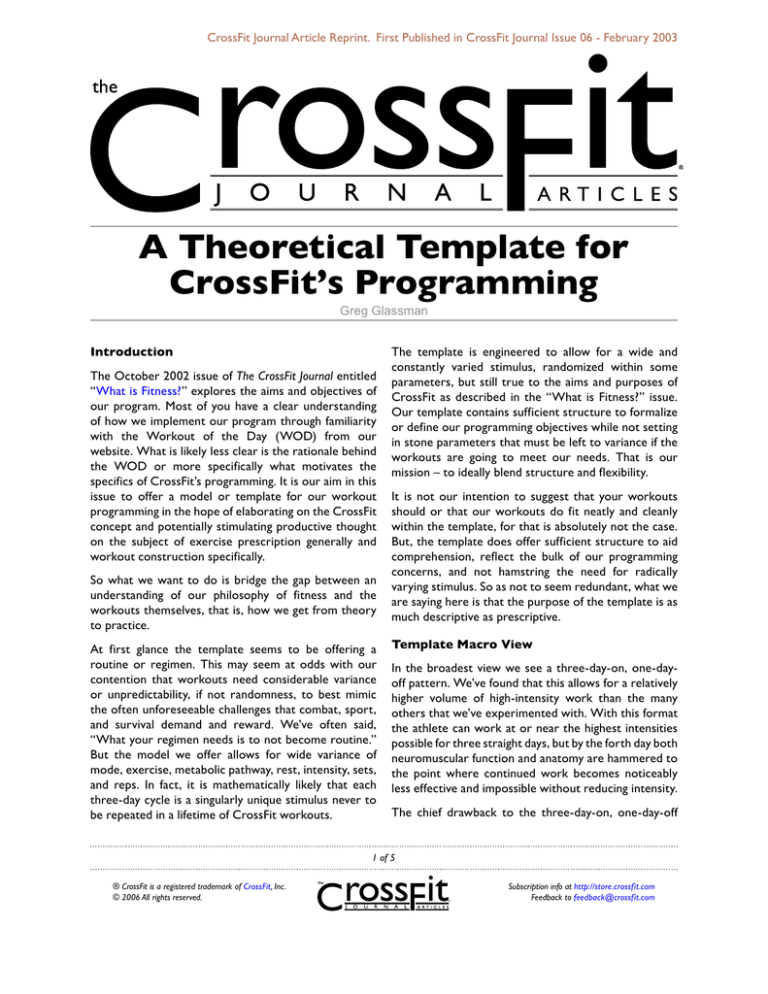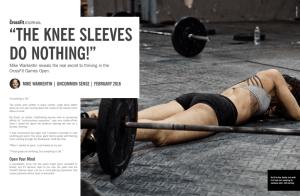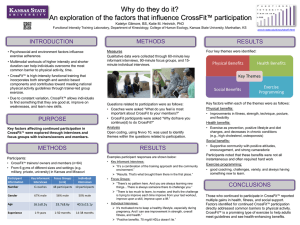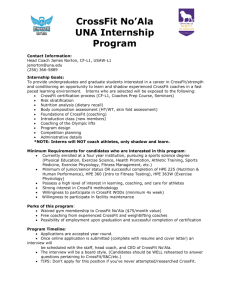
CrossFit Journal Article Reprint. First Published in CrossFit Journal Issue 06 - February 2003
A Theoretical Template for
CrossFit’s Programming
Greg Glassman
Introduction
The October 2002 issue of The CrossFit Journal entitled
“What is Fitness?” explores the aims and objectives of
our program. Most of you have a clear understanding
of how we implement our program through familiarity
with the Workout of the Day (WOD) from our
website. What is likely less clear is the rationale behind
the WOD or more specifically what motivates the
specifics of CrossFit’s programming. It is our aim in this
issue to offer a model or template for our workout
programming in the hope of elaborating on the CrossFit
concept and potentially stimulating productive thought
on the subject of exercise prescription generally and
workout construction specifically.
So what we want to do is bridge the gap between an
understanding of our philosophy of fitness and the
workouts themselves, that is, how we get from theory
to practice.
At first glance the template seems to be offering a
routine or regimen. This may seem at odds with our
contention that workouts need considerable variance
or unpredictability, if not randomness, to best mimic
the often unforeseeable challenges that combat, sport,
and survival demand and reward. We’ve often said,
“What your regimen needs is to not become routine.”
But the model we offer allows for wide variance of
mode, exercise, metabolic pathway, rest, intensity, sets,
and reps. In fact, it is mathematically likely that each
three-day cycle is a singularly unique stimulus never to
be repeated in a lifetime of CrossFit workouts.
The template is engineered to allow for a wide and
constantly varied stimulus, randomized within some
parameters, but still true to the aims and purposes of
CrossFit as described in the “What is Fitness?” issue.
Our template contains sufficient structure to formalize
or define our programming objectives while not setting
in stone parameters that must be left to variance if the
workouts are going to meet our needs. That is our
mission – to ideally blend structure and flexibility.
It is not our intention to suggest that your workouts
should or that our workouts do fit neatly and cleanly
within the template, for that is absolutely not the case.
But, the template does offer sufficient structure to aid
comprehension, reflect the bulk of our programming
concerns, and not hamstring the need for radically
varying stimulus. So as not to seem redundant, what we
are saying here is that the purpose of the template is as
much descriptive as prescriptive.
Template Macro View
In the broadest view we see a three-day-on, one-dayoff pattern. We’ve found that this allows for a relatively
higher volume of high-intensity work than the many
others that we’ve experimented with. With this format
the athlete can work at or near the highest intensities
possible for three straight days, but by the forth day both
neuromuscular function and anatomy are hammered to
the point where continued work becomes noticeably
less effective and impossible without reducing intensity.
The chief drawback to the three-day-on, one-day-off
of 5
® CrossFit is a registered trademark of CrossFit, Inc.
© 2006 All rights reserved.
Subscription info at http://store.crossfit.com
Feedback to feedback@crossfit.com
Theoretical Template for CF Programming (continued...)
Table 1 - Template Macro View
Day
1
M
2
G
W
Day
wk 1
1
M
2
G
W
wk 2
G
wk 3
W
3
M
G
W
4
OFF
3 days on, 1 day off
5
6
7
G
W
G
M
W
M
5 days on, 2 days off
3
4
5
M
M
W
G
G
W
W
G
G
M
M
W
W
M
M
W
W
G
G
M
M
G
6
OFF
7
OFF
OFF
OFF
OFF
OFF
regimen is that it does not sync with the five-day-on,
two-day-off pattern that seems to govern most of
the world’s work habits. The regimen is at odds with
the seven-day week. Many of our clients are running
programs within professional settings, often academic,
where the five-day workweek with weekends off is de
rigueur. Others have found that the scheduling needs of
family, work, and school require scheduling workouts on
specific days of the week every week. For these people
we have devised a five-days-on, two-days-off regimen
that has worked very well.
8
OFF
9
W
10
M
G
11
W
M
G
12
OFF
Modalities
M = monostructural metabolic
conditioning or “cardio”
G = gymnastics, bodyweight
exercises
W = weightlifting, powerlifting and
olympic lifts
effective pattern. There are other factors that will
ultimately overshadow any disadvantages inherent in the
potentially less effective regimen, such as convenience,
attitude, exercise selection, and pacing.
For the remainder of this article the three-day cycle
is the one in discussion, but most of the analysis and
discussion applies perfectly to the five-day cycle.
Elements by Modality
Looking at the Template Macro View (Table 1) it can
readily be seen that the workouts are composed
The workout of the day was originally a five-on, two- of three distinct modalities: metabolic conditioning
off pattern and it worked perfectly. But the three(“M”), gymnastics (“G”),
on, one-off pattern was
and weightlifting (“W”).
devised to increase both the
The metabolic conditioning
intensity and recovery of the
is monostructural activities
...the model we offer allows for
workouts and the feedback
commonly referred to as
we’ve received and our
wide variance of mode, exercise,
“cardio,” the purpose of
observations suggest that it
which is primarily to improve
metabolic
pathway,
rest,
intensity,
was successful in this regard.
cardiorespiratory capacity
sets, and reps.
and stamina. The gymnastics
If life is easier with the fivemodality comprises body
on, two-off pattern, don’t
weight exercises/elements
hesitate to employ it. The
difference in potential between the two may not warrant or calisthenics and its primary purpose is to improve
restructuring your entire life to accommodate the more body control by improving neurological components
of 5
® CrossFit is a registered trademark of CrossFit, Inc.
© 2006 All rights reserved.
Subscription info at http://store.crossfit.com
Feedback to feedback@crossfit.com
Theoretical Template for CF Programming (continued...)
Table 2 - Exercises by Modality
Gymnastics
Metabolic Conditioning
Weightlifting
Air Squat
Pull-up
Push-up
Dip
Handstand Push-up
Rope Climb
Muscle-Up
Press to Handstand
Back Extension
Sit-up
Jumps
Lunges
Run
Bike
Row
Jump Rope
Deadlifts
Cleans
Presses
Snatch
Clean and Jerk
Medicine Ball Drills
Kettlebell Swing
like coordination, balance, agility, and accuracy, and
to improve functional upper body capacity and trunk
strength. The weightlifting modality comprises the
most important weight training basics, Olympic lifts
and powerlifting, where the aim is primarily to increase
strength, power, and hip/leg capacity.
Table 2 gives the common exercises used by our
program, separated by modality, in fleshing out the
routines.
For metabolic conditioning the exercises are run, bike,
row, and jump rope. The gymnastics modality includes
air squats, pull-ups, push-ups, dips, handstand push-ups,
rope climb, muscle-ups, presses to handstand, back/hip
extensions, sit-ups, and jumps (vertical, box, broad,
etc.). The weightlifting modality includes deadlifts,
cleans, presses, the snatch, the clean and jerk, medicine
ball drills and throws, and kettlebell swings.
The elements, or exercises, chosen for each modality
were selected for their functionality, neuroendocrine
response, and overall capacity to dramatically and
broadly impact the human body.
Workout Structure
The workouts themselves are each represented by
the inclusion of one, two, or three modalities for each
day. Days 1, 5, and 9 are each single modality workouts
whereas days 2, 6, and 10 include two modalities each,
and finally, days 3, 7, and 11 use three modalities each.
In every case each modality is represented by a single
exercise or element, i.e., each M, W, and G represents a
single exercise from metabolic conditioning, weightlifting,
and gymnastics modalities respectively.
When the workout includes a single exercise (days 1, 5,
and 9) the focus is on a single exercise or effort. When
the element is the single “M” (day 1) the workout is
a single effort and is typically a long, slow, distance
effort. When the modality is a single “G” (day 5) the
workout is practice of a single skill and typically this
skill is sufficiently complex to require great practice and
may not be yet suitable for inclusion in a timed workout
because performance is not yet adequate for efficient
inclusion. When the modality is the single “W” (day 9)
the workout is a single lift and typically performed at
high weight and low rep. It is worth repeating that the
focus on days 1, 5, and 9 is single efforts of “cardio”
at long distance, improving high-skill more complex
gymnastics movements, and single/low rep heavy
weightlifting basics, respectively. This is not the day to
work sprints, pull-ups, or high rep clean and jerk - the
other days would be more appropriate.
On the single-element days (1, 5, and 9), recovery is
not a limiting factor. For the “G” and “W” days rest
is long and deliberate and the focus is kept clearly on
improvement of the element and not on total metabolic
effect.
For the two-element days (2, 6, and 10), the structure
is typically a couplet of exercises performed alternately
of 5
® CrossFit is a registered trademark of CrossFit, Inc.
© 2006 All rights reserved.
Subscription info at http://store.crossfit.com
Feedback to feedback@crossfit.com
Theoretical Template for CF Programming (continued...)
Table 3 - Workout Structure
Days
Single-Element Days
(1, 5, 9)
Two-Element Days
(2, 6, 10)
Three-Element Days
(3, 7, 11)
Priority
Element Priority
Task Priority
Time Priority
Structure
(set structure)
M: Single Effort
G: Single Skill
W: Single Lift
Couplet repeated 3-5
times for time
Triplet repeated for 20
minutes for rotations
(intensity)
M: Long, Slow Distance
G: High Skill
W: Heavy
Two moderately to
intensely challenging
elements
Three lightly to
moderately challenging
elements
Work Recovery
Character
Recovery not a limiting
factor
Work/rest interval
management critical
Work/rest interval
marginal factor
until repeated for a total of 3, 4, or most commonly 5
rounds and performed for time. We say these days are
“task priority” because the task is set and the time varies.
The workout is very often scored by the time required
to complete five rounds. The two elements themselves
are designed to be moderate to high intensity and workrest interval management is critical. These elements are
made intense by pace, load, reps or some combination.
Ideally the first round is hard but possible, whereas the
second and subsequent rounds will require pacing, rest,
and breaking the task up into manageable efforts. If the
second round can be completed without trouble, the
elements are too easy.
For the three-element days (3, 7, and 11), the structure
is typically a triplet of exercises, this time repeated for
20 minutes and performed and scored by number of
rotations completed in twenty minutes. We say these
Table 4 - Workout Examples
Days
1
2
3
4
5
6
7
8
9
10
11
12
M
GW
MGW
G
WM
GWM
W
MG
WMG
Run 10K
(5 handstand push-ups/225 x 5 deadlifts + 20 lbs/round) x 5 for time
Run 400m/10 pull-ups/”Thruster” 50% BW x 15 for 20 min for rotations
OFF
Practice handstands for 45 minutes
(Bench press 75% BW x 10/Row 500m) x 5 for time
Lunges 100ft./push-press 50% BW x 15/row 500 m for 20 min for rotations
OFF
Deadlift 5-3-3-2-2-2-1-1-1 reps
(Run 200m/box jump 30 in x 10) x 5 for time
Clean 50% BW x 20/bike 1 mile/15 push-ups for 20 min for rotations
OFF
of 5
® CrossFit is a registered trademark of CrossFit, Inc.
© 2006 All rights reserved.
Subscription info at http://store.crossfit.com
Feedback to feedback@crossfit.com
Theoretical Template for CF Programming (continued...)
workouts are “time priority” because the athlete is kept
moving for a specified time and the goal is to complete
as many cycles as possible. The elements are chosen in
order to provide a challenge that manifests only through
repeated cycles. Ideally the elements chosen are not
significant outside of the blistering pace required to
maximize rotations completed within the time (typically
20 minutes) allotted. This is in stark contrast to the twoelement days, where the elements are of a much higher
intensity. This workout is tough, extremely tough, but
managing work-rest intervals is a marginal factor.
Each of the three distinct days has a distinct character.
Generally speaking, as the number of elements increases
from one to two to three, the workout’s effect is due
less to the individual element selected and more to the
effect of repeated efforts.
Application
The template in discussion did not generate our Workout
of the Day, but the qualities of one, two, and three
element workouts motivated the template’s design.
Our experience in the gym and the feedback from our
athletes following the WOD have demonstrated that
the mix of one, two, and three element workouts are
crushing in their impact and unrivaled in bodily response.
The information garnered through your feedback on the
WOD has given CrossFit an advantage in estimating and
evaluating the effect of workouts that may have taken
decades or been impossible without the Internet.
Typically our most effective workouts, like art, are
remarkable in composition, symmetry, balance, theme,
and character. There is a “choreography” of exertion
that draws from a working knowledge of physiological
response, a well-developed sense of the limits of
human performance, the use of effective elements,
experimentation, and even luck. Our hope is that this
model will aid in learning this art.
The template encourages new skill development,
generates unique stressors, crosses modes, incorporates
quality movements, and hits all three metabolic pathways.
It does this within a framework of sets and reps and a
cast of exercises that CrossFit has repeatedly tested and
proven effective. We contend that this template does
a reasonable job of formally expressing many CrossFit
objectives and values.
Greg Glassman is the founder (with Lauren
Glassman) of CrossFit, Inc. and CrossFit Santa
Cruz and is the publisher of the CrossFit Journal.
of 5
® CrossFit is a registered trademark of CrossFit, Inc.
© 2006 All rights reserved.
Subscription info at http://store.crossfit.com
Feedback to feedback@crossfit.com




